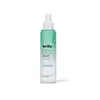What's inside
What's inside
 Key Ingredients
Key Ingredients

 Benefits
Benefits

 Concerns
Concerns

 Ingredients Side-by-side
Ingredients Side-by-side

Water
Skin ConditioningGlycerin
HumectantButylene Glycol
HumectantBetaine
HumectantGlycereth-26
HumectantZeolite
AbsorbentAloe Barbadensis Leaf Extract
EmollientSodium Hyaluronate
HumectantMomordica Charantia Fruit Extract
Skin ConditioningLactobacillus Ferment
Skin ConditioningGlycyrrhiza Glabra Root Extract
BleachingPsidium Guajava Leaf Extract
AstringentRosa Hybrid Flower Extract
Skin ConditioningCamellia Sinensis Leaf Extract
AntimicrobialCentella Asiatica Extract
CleansingHouttuynia Cordata Extract
Skin ConditioningXylitol
HumectantPEG-60 Hydrogenated Castor Oil
EmulsifyingCitric Acid
BufferingSodium Citrate
BufferingEthylhexylglycerin
Skin ConditioningCaprylyl Glycol
EmollientHydroxyacetophenone
AntioxidantLavandula Angustifolia Oil
MaskingCitrus Grandis Peel Oil
MaskingCitrus Aurantifolia Oil
CleansingCitrus Aurantium Dulcis Peel Oil
MaskingMelaleuca Alternifolia Leaf Oil
AntioxidantLimonene
PerfumingWater, Glycerin, Butylene Glycol, Betaine, Glycereth-26, Zeolite, Aloe Barbadensis Leaf Extract, Sodium Hyaluronate, Momordica Charantia Fruit Extract, Lactobacillus Ferment, Glycyrrhiza Glabra Root Extract, Psidium Guajava Leaf Extract, Rosa Hybrid Flower Extract, Camellia Sinensis Leaf Extract, Centella Asiatica Extract, Houttuynia Cordata Extract, Xylitol, PEG-60 Hydrogenated Castor Oil, Citric Acid, Sodium Citrate, Ethylhexylglycerin, Caprylyl Glycol, Hydroxyacetophenone, Lavandula Angustifolia Oil, Citrus Grandis Peel Oil, Citrus Aurantifolia Oil, Citrus Aurantium Dulcis Peel Oil, Melaleuca Alternifolia Leaf Oil, Limonene
Water
Skin ConditioningLavandula Angustifolia Flower Water
Skin ConditioningPropylene Glycol
HumectantPolysorbate 20
EmulsifyingAloe Barbadensis Leaf Juice
Skin ConditioningLavandula Angustifolia Oil
MaskingChamomilla Recutita Flower Extract
MaskingFucus Vesiculosus Extract
Emollient3-O-Ethyl Ascorbic Acid
Skin ConditioningThymus Vulgaris Leaf Extract
Skin ProtectingSilver Citrate
AntimicrobialPotassium Sorbate
PreservativeSodium Benzoate
MaskingBenzophenone-4
UV AbsorberTriethanolamine
BufferingZeolite
AbsorbentSodium Sulfate
Citric Acid
BufferingSodium Chloride
MaskingCI 60730
Cosmetic ColorantWater, Lavandula Angustifolia Flower Water, Propylene Glycol, Polysorbate 20, Aloe Barbadensis Leaf Juice, Lavandula Angustifolia Oil, Chamomilla Recutita Flower Extract, Fucus Vesiculosus Extract, 3-O-Ethyl Ascorbic Acid, Thymus Vulgaris Leaf Extract, Silver Citrate, Potassium Sorbate, Sodium Benzoate, Benzophenone-4, Triethanolamine, Zeolite, Sodium Sulfate, Citric Acid, Sodium Chloride, CI 60730
 Reviews
Reviews

Ingredients Explained
These ingredients are found in both products.
Ingredients higher up in an ingredient list are typically present in a larger amount.
Citric Acid is an alpha hydroxy acid (AHA) naturally found in citrus fruits like oranges, lemons, and limes.
Like other AHAs, citric acid can exfoliate skin by breaking down the bonds that hold dead skin cells together. This helps reveal smoother and brighter skin underneath.
However, this exfoliating effect only happens at high concentrations (20%) which can be hard to find in cosmetic products.
Due to this, citric acid is usually included in small amounts as a pH adjuster. This helps keep products slightly more acidic and compatible with skin's natural pH.
In skincare formulas, citric acid can:
While it can provide some skin benefits, research shows lactic acid and glycolic acid are generally more effective and less irritating exfoliants.
Most citric acid used in skincare today is made by fermenting sugars (usually from molasses). This synthetic version is identical to the natural citrus form but easier to stabilize and use in formulations.
Read more about some other popular AHA's here:
Learn more about Citric AcidLavandula Angustifolia Oil is more commonly known as lavender essential oil. It is considered a fragrancing ingredient.
Lavender imparts a famous scent. While the smell is lovely, this ingredient and may sensitize skin in topical products. This is because about 85% of the oil is made up of linalool and linalyl acetate.
When exposed to air, these two compounds become strong allergens. This ingredient exhibits cytotoxicity at low concentrations; amounts of 0.25% have been shown to damage skin cells.
A study from Japan found this ingredient caused lavender sensitivity after widespread exposure.
Lavender essential oil has some antimicrobial, antibacterial, and anti-inflammatory properties. However, the cons of this ingredient may outweight the pros.
More research is needed to confirm lavender essential oil's effects when used in aromatherapy.
Lavandula Angustifolia is known as the English Lavender and famous for creating purple fields in Provence, France.
Learn more about Lavandula Angustifolia OilWater. It's the most common cosmetic ingredient of all. You'll usually see it at the top of ingredient lists, meaning that it makes up the largest part of the product.
So why is it so popular? Water most often acts as a solvent - this means that it helps dissolve other ingredients into the formulation.
You'll also recognize water as that liquid we all need to stay alive. If you see this, drink a glass of water. Stay hydrated!
Learn more about WaterWe don't have a description for Zeolite yet.